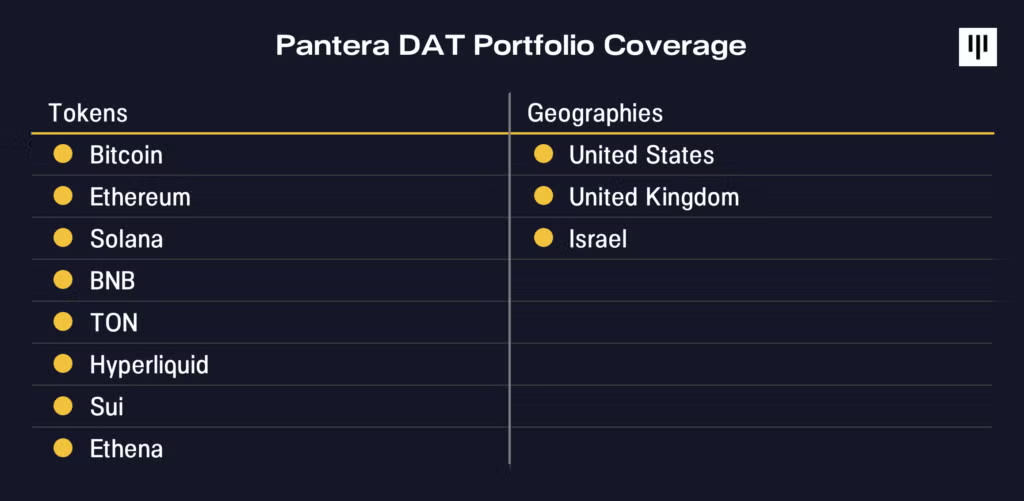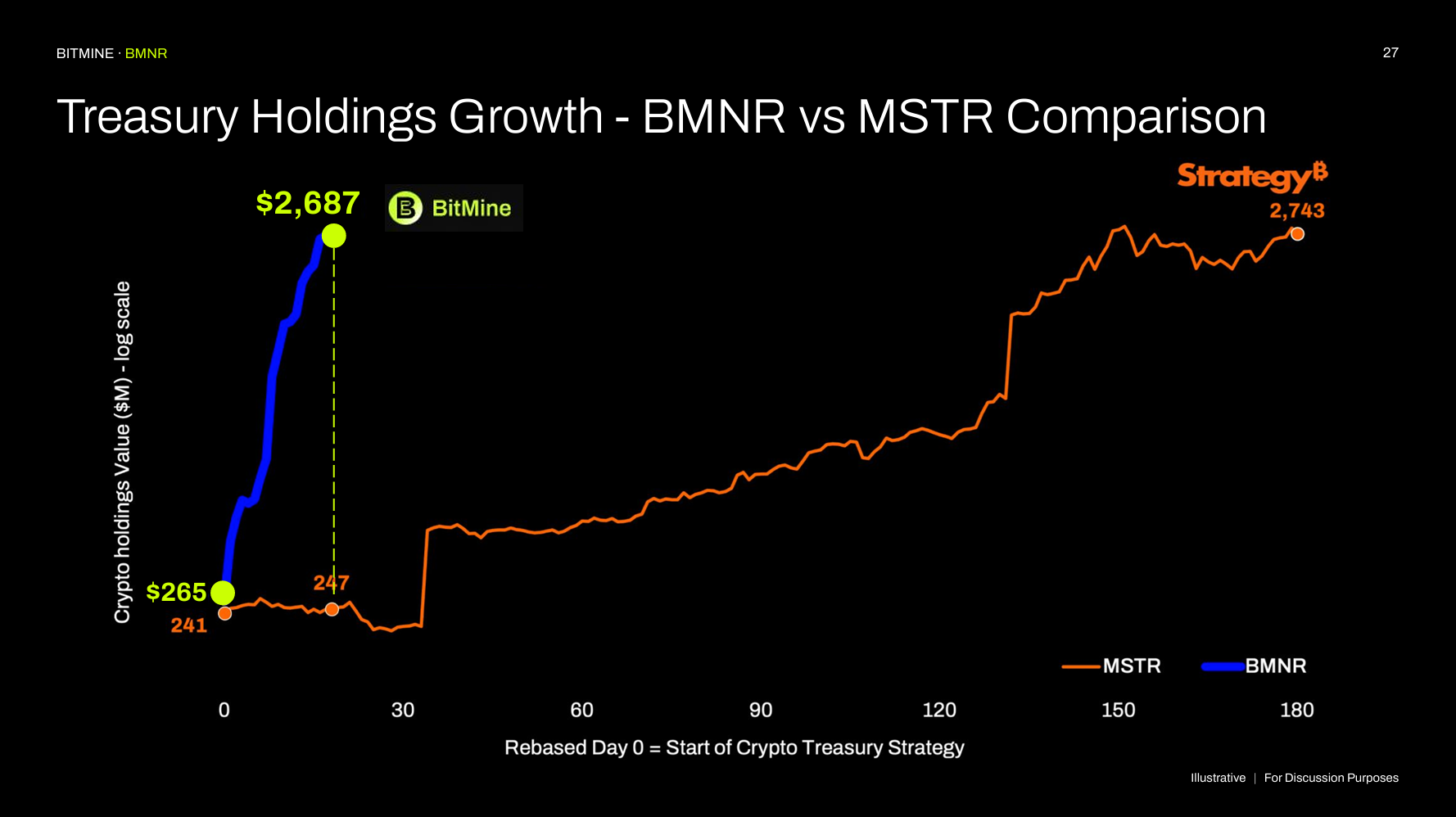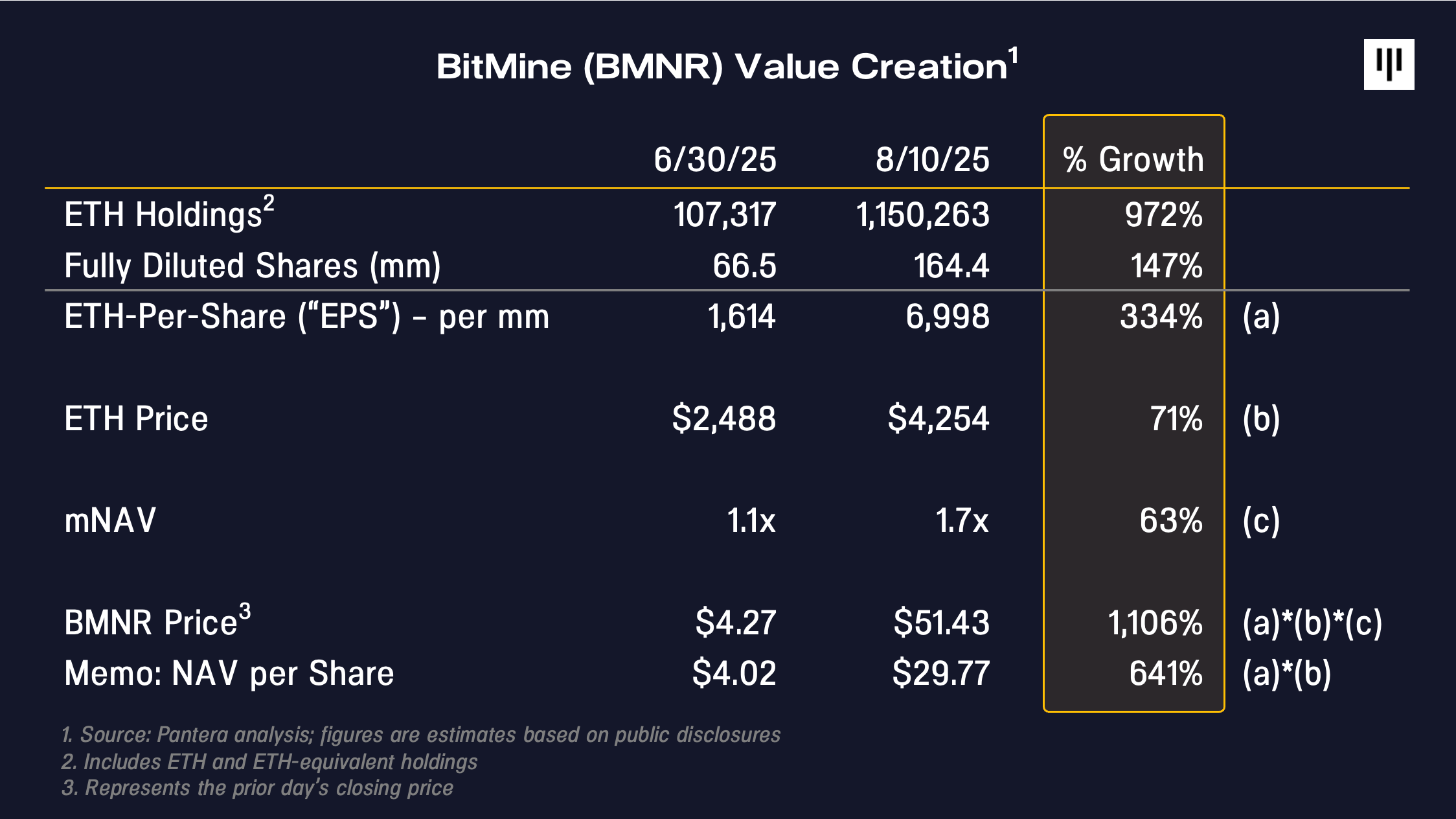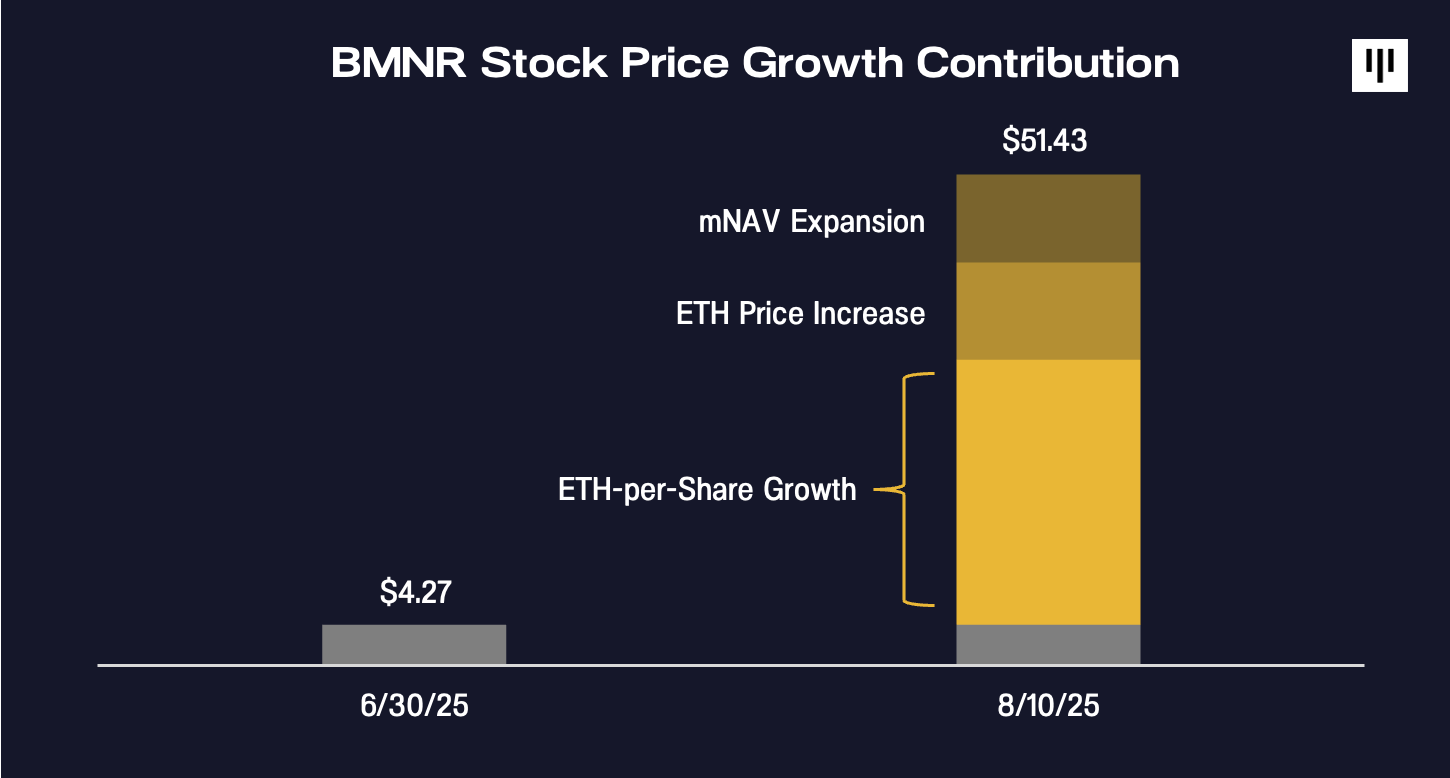Through the DAT strategy, BitMine has embarked on the path of wealth growth in Ethereum.
Author: Cosmo Jiang, Erik Lowe
Compiled by: Deep Tide TechFlow
Our investment theory in Digital Asset Treasuries (DATs) is based on a simple assumption:
DATs can increase the net asset value per share by generating returns, thereby accumulating more token holdings over time, rather than just holding spot positions.
Therefore, investing in DATs has the potential to yield higher returns compared to directly holding tokens or holding tokens through exchange-traded funds (ETFs).
Pantera has invested over $300 million in various tokens and regions of Digital Asset Treasuries (DATs). These DATs leverage their unique advantages to expand their digital asset holdings through strategic operations that enhance per-share value. Below is a brief overview of our DAT portfolio coverage.

BitMine Immersion (BMNR) is the first investment of the Pantera DAT Fund, showcasing a company with a clear strategic plan and execution capability. Tom Lee, Chairman of Fundstrat, elaborated on BitMine's long-term vision—acquiring 5% of the total ETH supply, a goal referred to as "5% Alchemy." We believe it is very meaningful to interpret how an efficiently operated Digital Asset Treasury (DAT) creates value through the case of BMNR.
BitMine (BMNR) Case Study
Since BitMine launched its fund management strategy, it has become the largest ETH fund management institution globally and the third-largest DAT (after Strategy and XXI). As of August 10, 2025, BMNR holds a total of 1,150,263 ETH, valued at $4.9 billion. Additionally, BMNR ranks 25th in U.S. liquidity, with an average daily trading volume of $2.2 billion (based on the five-day average trading volume as of August 8, 2025).
Ethereum Case
The most important factor for the success of DATs lies in the long-term investment value of their underlying tokens. BitMine's DAT strategy is based on a core argument: as Wall Street shifts on-chain, Ethereum will become one of the largest macro trends in the next decade. As we wrote in last month's article, "The Great Onchain Migration" is underway, with the importance of tokenization innovation and stablecoins becoming increasingly prominent.
Currently, there are $25 billion of real-world assets existing on public blockchains—additionally, there are $260 billion in stablecoins, which collectively have become the 17th largest holder of U.S. Treasury bonds.
“Stablecoins have become the ChatGPT story of the crypto space.”
– Tom Lee, Chairman of BitMine, Pantera DAT Call, July 2, 2025
Most of these activities occur on Ethereum, positioning ETH to benefit from the growing demand for block space. As financial institutions increasingly rely on Ethereum's security to support their operations, they will be incentivized to participate in Ethereum's Proof-of-Stake network—further driving demand for ETH accumulation.
Growth in ETH per Share (EPS)
After establishing the investment value of the underlying token, the core of the Digital Asset Treasury (DAT) business model is to maximize the growth of the number of tokens per share. Here are the main methods for increasing the number of tokens per share:
Issue shares at a premium to the net asset value (NAV) per token.
Issue convertible bonds and other equity-linked securities to monetize the volatility of stocks and underlying tokens.
Acquire more tokens through staking rewards, DeFi yields, and other operational income. It is important to note that this is an additional advantage unique to ETH and other smart contract token treasuries, which early Bitcoin treasuries (like Strategy) do not possess.
Acquire other digital asset treasuries trading close to or below net asset value (NAV).
In this regard, BitMine has achieved remarkable growth in its per-share ETH earnings (coincidentally also referred to as "EPS") within the first month of launching its ETH treasury strategy, far exceeding other digital asset treasuries (DATs). In comparison, the amount of ETH accumulated by BitMine in its first month has already surpassed the total accumulated by Strategy (formerly MicroStrategy) in the first six months of executing a similar strategy.
BitMine primarily increases its per-share quantity through issuing shares and generating staking rewards, and we expect BitMine to likely expand its toolset in the near future to include issuing convertible debt and other financial instruments.

Source: BitMine Company Presentation, July 27, 2025
Value Creation Actions
The price of a Digital Asset Treasury (DAT) can be broken down into the product of the following three components: (a) the number of tokens per share, (b) the price of the underlying token, and (c) the net asset value multiple (mNAV).
As of the end of June, BMNR's stock price was $4.27 per share, approximately 1.1 times its initial DAT financing NAV of $4 per share. Just over a month later, the stock closed at $51, about 1.7 times its estimated NAV of $30 per share.
This means that the stock price increased by 1,100% in just over a month, with the following contributions: (a) the number of tokens per share (EPS) grew by approximately 330%, contributing about 60% of the increase; (b) the ETH price rose from $2,500 to $4,300, contributing about 20% of the increase; (c) mNAV expanded to 1.7 times, contributing about 20% of the increase.
This indicates that the significant rise in BMNR's stock price was primarily driven by the growth in its number of ETH per share (EPS). This is the core driver controllable by management and fundamentally distinguishes Digital Asset Treasuries (DATs) from merely holding spot assets.


The third factor we have yet to explore in depth is the net asset value multiple (mNAV). Naturally, one might ask: why would someone pay a premium for the net asset value (NAV) of a Digital Asset Treasury (DAT)?
Here, it can be likened to balance sheet-based financial businesses, including banks. Banks generate returns through assets, and investors will give a valuation premium to those banks that can consistently generate returns exceeding their cost of capital. For example, the highest quality banks typically trade at a premium to net asset value (NAV) or book value, such as JPMorgan (JPM) trading at over 2 times its valuation.
Similarly, if investors believe that a particular DAT can consistently grow its net asset value (NAV) per share, they may be willing to value that DAT at a premium. We believe that BMNR's monthly growth of approximately 640% in net asset value (NAV) per share is sufficient to justify its mNAV premium.
Whether BitMine can continue to execute its strategy will be validated over time, and it will inevitably face challenges in the process. BitMine's management team and its performance thus far have attracted heavyweight supporters from the traditional finance sector, including Stan Druckenmiller, Bill Miller, and ARK Invest. We expect that the growth story of the highest quality DATs will, like Strategy, attract more institutional investors.
免责声明:本文章仅代表作者个人观点,不代表本平台的立场和观点。本文章仅供信息分享,不构成对任何人的任何投资建议。用户与作者之间的任何争议,与本平台无关。如网页中刊载的文章或图片涉及侵权,请提供相关的权利证明和身份证明发送邮件到support@aicoin.com,本平台相关工作人员将会进行核查。




